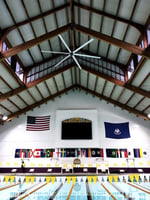Are size and speed important when choosing a ceiling fan? The short answer is yes. Because of the...
HVLS Fans and Pollen: How to Improve Spring Air Quality
Although spring brings agreeable weather and lots of sunshine, it also brings a serious tormentor for many people: pollen. Every year over 50 million Americans suffer from a condition called allergic rhinitis, which causes sneezing, a runny nose, and itchy eyes. Pollen is far and away the biggest culprit of spring allergies. Since it's so small and comes from so many types of trees and plants, it can be difficult to contain. Pollen can be especially problematic in facilities with many open doors and windows. Fortunately for allergy sufferers, HVLS fans provide an easy way for facilities to improve spring air quality and reduce the impact of pollen on employees.
Airflow: The Key to Controlling Pollen
Pollen grains are a plant substance released into the air from the male part of a seed plant. When pollen is deposited on female plant ovules, it fertilizes the plant so that it can create seeds. Pollen is usually microscopic. This makes it even more difficult to manage in a facility. It's hard to get rid of something you can't see.
Improving your building's airflow and ventilation is crucial for getting a handle on pollen. With sufficient airflow, pollen grains in your space are removed through exhaust ports that expel air out of a building. The pollen that does get into the building will be less harmful because it does not linger around your employees and land in their eyes, nose, and mouth. A steady current of air carries it away.
HVLS Fans Promote Airflow for Spring Pollen Control
When it comes to airflow in your facility, there are few options as efficient as an HVLS fan. A single fan can displace over 250,000 cubic feet of air per minute (CFM). No matter the size of your space, you can find an HVLS fan that will fit your budget and airflow needs.
Besides how efficient they are at promoting air circulation to remove pollen, HVLS fans can also help get rid of other problematic elements in your facility's air. Mold spores, bacteria, and other chemicals can lead to a condition known as Sick Building Syndrome, where occupants suffer from symptoms similar to seasonal allergies. An HVLS fan helps prevent these problems by increasing airflow so that your facility gets rid of harmful toxins more quickly.
Other Tips for Spring Pollen Control
Besides installing an HVLS fan, there are a few other steps you can take to control pollen in your building:
- Use a HEPA filter. They are much more effective than standard HVAC filters: by law, HEPA filters must catch over 99% of particles coming through them, including dust, smoke, and pollen.
- Keep doors and windows closed whenever possible, especially if they are close to plants that give off lots of pollen.
- Clean your HVAC system. Dust and pollen often accumulate inside HVAC ducts, which can be pushed out to the rest of the facility.
Don't let pollen interfere with the productivity of your operation or the health of your team. Find the right HVLS fan to increase circulation and keep your spring air fresh and clean.
www.macroairfans.com


